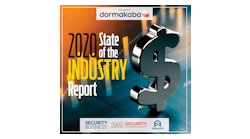
This article originally appeared in the February 2021 issue of Security Business magazine. When sharing, don’t forget to mention @SecBusinessMag on Twitter and Security Business magazine on LinkedIn.
Enterprise security technologies – those which protect the people, assets and properties of large companies, campuses and similar sophisticated organizations – have experienced numerous big trends and buzzwords over the past decade. One of those is the Smart Building – the idea that various technologies can work together to improve the safety, security, energy utilization and other operational aspects of a large building to optimize cost and operational efficiencies.
Security system providers have considered themselves at the center of this ecosystem, most having some form of smart, safe or green solutions in their portfolio and touting their value in large integrated systems. Not surprisingly, enterprise end-users have invested heavily in deploying these solutions as they seek ways to improve ROI from their security and building systems.
Then came the COVID-19 pandemic, and everything changed.
Large security projects were delayed as organizations determined the financial impact of significantly reduced commerce and travel. What funds were available were redirected to near-term needs such as employee collaboration technologies and temperature scanners necessary to ensure continuity of operations. Manufacturers pivoted their product roadmaps almost immediately, developing or repurposing solutions for previously unknown use-cases such as social distancing and mask detection.
The industry was changing before our eyes, and the future was very uncertain.
The Industry in 2021
As we enter 2021, the ‘new normal’ is starting to emerge. People are slowly returning to work, school and travel. Vaccines are on the horizon, promising to accelerate the process. But what will this new normal look like, and how will it impact the security industry?
Genetec recently released a study on the State of Physical Security 2020, which surveyed more than 1,000 people from various organizations and geographies about the impact COVID-19 has had on their security planning. The study indicated that while most organizations slowed or delayed security spending in 2020 due to the pandemic, the majority expect investment to resume or increase in 2021. Additionally, organizations stated their top challenge in 2021 will be managing employee and visitor health and safety, overtaking physical security threats as the top concern (learn more about this study at www.securityinfowatch.com/21165959).
In the 2020 State of the Security Industry: An Integrator’s Perspective, Security Business magazine revealed that security integrators have prioritized technology solutions that will help end-users manage health-related concerns as they return to work, including temperature screening, contactless access control, mask detection and occupancy monitoring solutions (access the full report at www.securityinfowatch.com/21202172).
But how are enterprise end users really thinking? The future of security technology will be heavily shaped by the manner in which companies return to work.
Has the Workplace been Forever Transformed?
I spoke with the Director of Workplace Strategy for a Fortune 100 company (let’s call them Acme Inc.), to learn more about their thoughts on the future. This feedback was very interesting and representative of similar companies, as many of them have collaborated and shared thinking on how to return to work and what the future workplace will look like.
One of the most remarkable takeaways was the speed at which they will – or won’t – return to in-person work. They anticipate their existing office space will be only 20% occupied in December of 2021. The requirement for wearing masks appears to be the primary mitigating factor. Their employees simply do not want to return to work when their experience in the office is significantly inferior to their experience at home.
This is a very important dynamic. Employee experience is more heavily influencing enterprise companies’ post-pandemic workplace planning. Why? It turns out as virtually every company moved to remote work in 2020, they determined it can be just as productive as in-person work in many cases. As such, large enterprises who have traditionally been the primary or premier employer in their city now must compete with companies from virtually any part of the country for talent. Employees have suddenly gained leverage as their employer options have expanded significantly, and in many cases offer a preferred experience by allowing work from home.
To counteract this threat, companies are planning workplaces that can meet or exceed the experience of working at home to entice people to return to work. “Acme” has said that home will be the default workspace for 50% of their employees in 2022 and beyond. Call centers will be close to 100% remote. In-person spaces will be provided, but their makeup will change from traditional cubicles and offices to meeting rooms, collaboration spaces and temporary areas for ‘focus work.’ Their goal is to maximize collaboration, innovation and productivity while enhancing company culture and employee satisfaction. Workplace strategy will shift to emphasize hospitality over attendance.
The Impact on Security
This shift poses a significant impact on the company’s plans for security and building technology. Building lobbies will change permanently, as health will be just as important as security. Screening kiosks will become the norm. These check-in stations – modernized versions of what is found in airports and hotel lobbies – will facilitate health checks, access control and visitor management. They will leverage touchless technologies such as proximity, facial recognition and thermal temperature scanning, and will be tightly integrated into existing access control, video surveillance, intrusion detection and building management systems.
Additionally, sensor technology will be relied upon heavily for occupancy detection and real estate optimization. Video surveillance with facial detection (not necessarily recognition), motion detectors and thermal cameras will be used to help companies determine how their space is being used and to manage health-related risks. Other types of sensors, such as those integrated directly into furniture and other workplace fixtures, must be integrated. They would rather find new ways to use existing systems than to invest in new systems that must be managed and administered separately.
Enterprise office buildings will look different in the future. This emphasis on ‘clean’, health-focused spaces will become the norm, and companies will invest in technology that enhances the employee experience as much as optimizing cost and operations. While the traditional need for mitigating security risks will not go away, solutions providers must adapt to this increased need for healthy workplaces.
And a new industry buzzword has emerged: The Clean Building.
Brandon Reich is CEO of SecureBI (www.securebi.com), a business and strategic advisory firm exclusively serving the physical security and IoT industries. In more than 20 years in the security industry, he has held executive positions at companies including Honeywell, Pelco and Pivot3. Follow him on Twitter at @Brandon_Reich or email him at [email protected].

Brandon Reich | Senior Director of Surveillance Solutions at Pivot3 Inc
Brandon Reich is CEO of SecureBI (www.securebi.com), a business and strategic advisory firm exclusively serving the physical security and IoT industries. In more than 20 years in the security industry, he has held executive positions at companies including Honeywell, Pelco and Pivot3. Follow him on Twitter at @Brandon_Reich or email him at [email protected].



